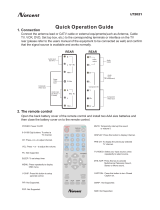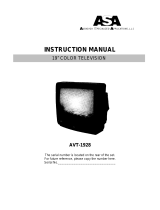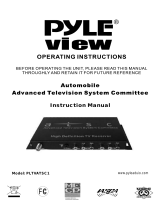CONTENTS
1 C
ONTENTS
Chapter 1: Your New TV . . . . . . . . . . . . . . .1.1
List of Features . . . . . . . . . . . . . . . . . . . . . . . . . . . . . . . . . . . . . . . . . .1.1
Familiarizing Yourself with Your New TV . . . . . . . . . . . . . . . . . . . . . .1.2
Front Panel Buttons . . . . . . . . . . . . . . . . . . . . . . . . . . . . . . .1.2
Side Panel Jacks . . . . . . . . . . . . . . . . . . . . . . . . . . . . . . . . . .1.3
Rear Panel Jacks (Depending on the model) . . . . . . . . . . . . .1.4
Remote Control . . . . . . . . . . . . . . . . . . . . . . . . . . . . . . . . . .1.5
Chapter 2: Installation . . . . . . . . . . . . . . . . 2.1
Connecting VHF and UHF Antennas . . . . . . . . . . . . . . . . . . . . . . . . .2.1
Antennas with 300-ohm Flat Twin Leads . . . . . . . . . . . . . . .2.1
Antennas with 75-ohm Round Leads . . . . . . . . . . . . . . . . . .2.2
Separate VHF and UHF Antennas . . . . . . . . . . . . . . . . . . . .2.2
Connecting Cable TV . . . . . . . . . . . . . . . . . . . . . . . . . . . . . . . . . . . . .2.2
Cable without a Cable Box . . . . . . . . . . . . . . . . . . . . . . . . . .2.2
Connecting to a Cable Box that Descrambles
All Channels . . . . . . . . . . . . . . . . . . . . . . . . . . . . . . . . . . . .2.3
Connecting to a Cable Box that Descrambles
some Channels . . . . . . . . . . . . . . . . . . . . . . . . . . . . . . . . . .2.3
Connecting a VCR . . . . . . . . . . . . . . . . . . . . . . . . . . . . . . . . . . . . . . .2.5
Connecting a Second VCR to Record from the TV . . . . . . . .2.6
Connecting a Camcorder . . . . . . . . . . . . . . . . . . . . . . . . . . . . . . . . . .2.6
Connecting a DVD Player, DTV Set-Top Box (480i, 480p, 1080i) . . .2.7
Connecting to Y, P
B
, P
R
. . . . . . . . . . . . . . . . . . . . . . . . . . . . .2.7
Connecting to regular audio and video jacks . . . . . . . . . . . .2.7
Connecting a DTV Set-Top Box (480p, 1080i) . . . . . . . . . . . . . . . . . .2.8
Installing Batteries in the Remote Control . . . . . . . . . . . . . . . . . . . . .2.9
Chapter 3: Operation . . . . . . . . . . . . . . . . . .3.1
Turning the TV On and Off . . . . . . . . . . . . . . . . . . . . . . . . . . . . . . . .3.1
Plug & Play Feature . . . . . . . . . . . . . . . . . . . . . . . . . . . . . . . . . . . . . .3.1
Using the Perfect Focus Feature . . . . . . . . . . . . . . . . . . . . . . . . . . . . .3.3
Adjusting Manual convergence . . . . . . . . . . . . . . . . . . . . . . . . . . . . .3.4
Adjust Red Convergence . . . . . . . . . . . . . . . . . . . . . . . . . . .3.5
Viewing the Menus and On-Screen Displays . . . . . . . . . . . . . . . . . . .3.6
Viewing the Menus . . . . . . . . . . . . . . . . . . . . . . . . . . . . . . .3.6
Viewing the Display . . . . . . . . . . . . . . . . . . . . . . . . . . . . . . .3.6
Selecting a Menu Language . . . . . . . . . . . . . . . . . . . . . . . . . . . . . . . .3.7
Selecting the Antenna Input . . . . . . . . . . . . . . . . . . . . . . . . . . . . . . . .3.7
Memorizing the Channels . . . . . . . . . . . . . . . . . . . . . . . . . . . . . . . . .3.8
Selecting the Video Signal-source . . . . . . . . . . . . . . . . . . . . .3.8
Storing Channels in Memory (Automatic Method) . . . . . . . .3.9
Adding and Erasing Channels (Manual Method) . . . . . . . . .3.9
Changing Channels . . . . . . . . . . . . . . . . . . . . . . . . . . . . . . . . . . . . .3.10
Using the Channel Buttons . . . . . . . . . . . . . . . . . . . . . . . .3.10
Using the Number Buttons . . . . . . . . . . . . . . . . . . . . . . . .3.10
Using the Previous Channel . . . . . . . . . . . . . . . . . . . . . . . .3.10
Selecting Your Favorite Channels . . . . . . . . . . . . . . . . . . . . . . . . . . .3.11
To Store Your Favorite Channels: . . . . . . . . . . . . . . . . . . . .3.11
To View Your Favorite Channels: . . . . . . . . . . . . . . . . . . . .3.11
Adding and Erasing Channels (Manual Method) . . . . . . . . . . . . . . .3.12
Labeling the Channels . . . . . . . . . . . . . . . . . . . . . . . . . . . . . . . . . . .3.13
Picture Control . . . . . . . . . . . . . . . . . . . . . . . . . . . . . . . . . . . . . . . .3.14
Customizing the Picture . . . . . . . . . . . . . . . . . . . . . . . . . . .3.14
Using Automatic Picture Settings . . . . . . . . . . . . . . . . . . . .3.15
Selecting the Color Tone . . . . . . . . . . . . . . . . . . . . . . . . . .3.16






















